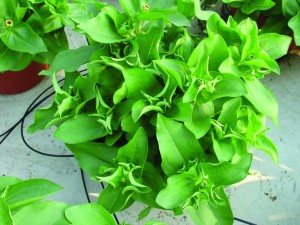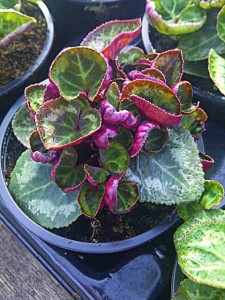How Calcium Plays A Critical Role In Plant Health

Calcium deficiency causes upward leaf curl on zinnias.
Every plant needs calcium to grow. In plant growth, calcium plays a critical role in strengthening the plant’s cell walls, which makes it harder for pathogens to invade the plant. Calcium also contributes to the growth of stronger stems.
Without adequate amounts of calcium, plants can experience a variety of problems. Calcium deficiency can manifest itself as chlorosis, necrosis, or abnormalities at the tips and margins of young leaves, as well as deformed bulbs and fruit. Once fixed in the plant, calcium becomes immobile and doesn’t move throughout the plant. Older plant tissue is unable to give up its calcium supply to the youngest growth; therefore, symptoms appear most often in the growing tips.
In growing media, calcium also contributes to the buffering capacity of the media. Having a high media pH doesn’t necessarily mean that adequate calcium is present. Some crops that exhibit calcium deficiency include ornamental cabbage and kale, tomatoes, and poinsettias.
Hot, Humid Weather Slows Calcium Uptake
In cabbage and kale, calcium deficiency is related to poor transpiration under hot and humid summer conditions. Calcium may be present in the media, but it doesn’t translocate up from the roots, resulting in leaf edge burn. Foliar spray applications of a calcium nitrate fertilizer (15.5-0-0 or 15-0-15) at 1½ teaspoons per gallon with the surfactant CapSil at one half a teaspoon per gallon greatly reduce the incidence of edge burn.
Calcium sprays should be made once a week when conditions favor deficiency, and continued until cooler and less humid weather sets in. Scheduling applications during morning or evening hours will help prevent phytotoxicity from the sprays.
Don’t Confuse Calcium Deficiency With Disease For Healthy Tomatoes
Blossom end rot of tomatoes is often mistaken for a disease, but calcium deficiency is a major contributor. Symptoms start as sunken, decaying areas at the blossom end of the fruit. Blossom end rot is typically first observed on the fruit furthest away from the stem. Plants are especially susceptible when exposed to sudden periods of drought and high soluble salts.
The availability of calcium to the tomato fruit decreases as total salts in the media or hydroponic solution increase. Fluctuations in media moisture should also be avoided, especially during fruit development. Take steps to improve transpiration by lowering humidity and increasing air movement. Utilize weekly foliar sprays of calcium nitrate with CapSil. A foliar spray of calcium chloride dihydrate with CapSil could be substituted for the calcium-nitrate spray.

Calcium deficiency in cyclamen results in hard cupping growth that detracts from the plant’s appearance.
Prevent Bract Edge Burn In Poinsettias With Foliar Calcium Sprays
Poinsettias can also suffer from calcium deficiency throughout their crop cycle. Foliar symptoms first occur as puckered leaves, often with the tip of the leaf hooked down toward the ground. Symptoms on bracts, which vary by variety and environmental conditions, include small white, brown, or black spots that can appear on bract edges or scattered across the bract between the veins. Some varieties may exhibit purple margins running down the sides of the bracts.
Any nutritional or environmental factors that inhibit the uptake of calcium into bract tissue increase the likelihood of bract edge burn. Bracts transpire less than the leaves. Lower transpiration means that less calcium moves from the media into the plant tissue. Therefore, applying calcium directly to the bracts as a spray is the most successful way of increasing tissue concentrations of calcium.
To minimize the risk of bract edge burn, apply foliar sprays of calcium chloride dihydrate plus CapSil to a glisten when the first true bracts are present. Calcium chloride dihydrate is preferred for calcium sprays on poinsettias for two reasons. First, calcium chloride dihydrate doesn’t contain nitrogen, which would make the tissue soft. Second, calcium chloride dihydrate lacks the dye that would stain the poinsettia bracts. Sprays can be made weekly and continue until the crop is shipped. Never spray this mixture when the plants are under water stress, or when air temperatures are above 85°F.
With poinsettia bracts, it’s sometimes difficult to discern where calcium problems stop and a disease begins. Calcium-deficient bracts often fall prey to Botrytis. However, bracts with adequate calcium can also develop Botrytis if the environmental conditions are ideal. When making calcium treatments in greenhouses with higher humidity, it’s suggested that you also treat for Botrytis.
Other crops susceptible to calcium deficiencies include cyclamen, lilies, primula, and zinnia. Encourage strong transpiration and use calcium sprays when conditions favor the development of deficiency symptoms in these crops, too.
Products other than those mentioned here may also be legal, safe, and effective. Always read and follow all label directions.









